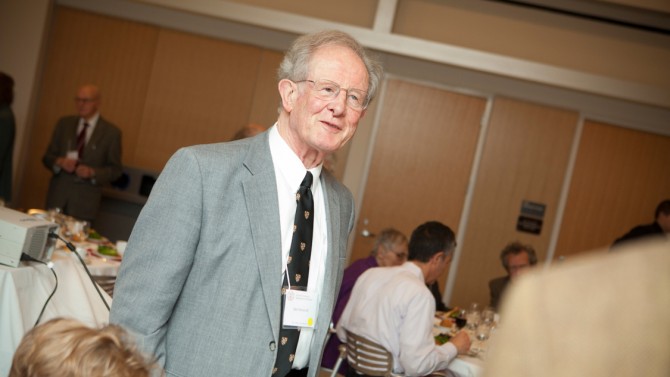Neil Ashcroft, world-renowned theoretical physicist, dies at 82
By David Nutt
Neil W. Ashcroft, the Horace White Professor of Physics Emeritus in the College of Arts and Sciences and a leading theorist in condensed matter physics, died March 15 in Ithaca. He was 82.
In the late 1960s and first half of the 1970s, he collaborated with David Mermin, professor emeritus of physics (A&S), to write “Solid State Physics,” which became the gold standard of textbooks for their discipline.
“For the generation of physicists reared during the last quarter of the 20th century, Neil Ashcroft and David Mermin’s textbook was the go-to bible of the field,” said Sol Gruner, the John L. Wetherill Professor of Physics Emeritus (A&S). “The textbook was so ubiquitous that the title, “Solid State Physics,” was rarely mentioned. Rather, people said simply ‘Check it out in Ashcroft and Mermin.’”
Ashcroft was born Nov. 27, 1938 in London. He received his bachelor of science in 1958 and his master of science in 1960, both from the University of New Zealand, and earned his Ph.D. from Cambridge University in 1964.
In 1965, he came to Cornell as a research associate and was appointed to the faculty as assistant professor of physics the following year. He became associate professor of physics in 1969 and professor of physics in 1975. He was named Horace White Professor in Physics in 1990.
Over the years, Ashcroft’s research interests encompassed density functional theory, matter under extreme pressures, strongly correlated many-particle systems and high-temperature superconductivity, superlattice hetero-structures, metallic hydrogen and its alloys, and metal-insulator and phase transitions.
He officially retired in 2006, but, in an unexpected twist, he soon began a new burst of scientific activity. After a serendipitous meeting with Roald Hoffmann, the Frank H.T. Rhodes Professor in Humane Letters Emeritus (A&S) and 1981 Nobel laureate in chemistry, Ashcroft joined Hoffmann’s research group. Their interdisciplinary collaboration was so productive it amounted to a research renaissance for Ashcroft.
“In 47 joint scientific papers over 15 years and in countless group meetings, I and my coworkers learned from Neil Ashcroft. And so did the community – superconductivity in high hydrides, a field suggested by Neil, has just blossomed,” Hoffman said. “Neil was wise and perceptive, fascinated by the border between chemistry and physics. Our collaborators and I valued his physical insight and remember his gentle wit. And miss him.”
Ashcroft not only helped shape the fundamentals of his field. He also had a knack for anticipating its future discoveries. For example, in 1968 he proposed that hydrogen – which is a gas at ambient conditions – could become metallic, and a high-temperature superconductor, at high pressures. Then, 28 years later, experimentalists produced partial proof of Ashcroft’s model – hydrogen molecules did indeed metallize. When his research group predicted in the 1990s that compressed lithium would transition from a highly symmetric structure, its atoms closely packed, to a less symmetrical structure with some electrons off the lithium nuclei, that risky prediction was quickly confirmed.
And just in the past six years, Ashcroft’s suggestion, originally made two decades ago, that high-temperature superconductivity could be found in high-pressure alloys of other hydrogen-rich elements was realized when several research groups achieved record high temperatures for superconducting LaH10 and SH3.
But Ashcroft’s most tangible legacy may have been “Solid State Physics.” Upon its publication in 1976, the book was immediately translated into Polish, Russian and Japanese, and later made its way into German, French and Portuguese, as well as physics classrooms around the world.
When Physics Today published an article in 2013 that both praised the book and questioned whether it needed to be updated to keep pace with scientific advances, Ashcroft wrote in response, “…laudatory comments about our book are generous in the extreme. David and I are both grateful, and together we hope that the aging process, of ourselves and of our textbook, will not unduly accelerate.”
“Neil Ashcroft was a colleague and close friend for over 50 years. The happiest years of my professional life were the six years Neil and I spent writing our book ‘Solid State Physics,’” Mermin said. “Neil had a wonderful sense of humor. The fun we were having permeates the book. It’s still thriving 45 years after it came out, still in its original edition. Unlike almost all technical books, I believe ours entertains the reader in much the same way that Neil and I entertained each other while writing it.
“Neil was an internationally famous solid-state physicist,” Mermin said. “He is, for example, one of the few Cornell faculty members to have been elected to the Russian Academy of Sciences.”
Ashcroft also played a vital role in launching the Cornell High Energy Synchrotron Source (CHESS), serving as its co-principal investigator and associate director from 1978 to 1989, and its deputy director from 1990-97, in addition to overseeing its proposal review panel and policy advisory board. He was also director of the Laboratory of Atomic and Solid State Physics from 1979 to 1984 and the Cornell Center for Materials Research from 1997 to 2000.
Among his many honors, Ashcroft was a member of the National Academy of Sciences, the American Association for the Advancement of Science, a fellow of the American Physical Society, an honorary fellow of the Royal Society of New Zealand, a Guggenheim memorial fellow, and winner of the 2003 Bridgman Award in high pressure physics, awarded by the International Association for the Advancement of High Pressure Science and Technology.
He is survived by his wife of 60 years, Judith, a longtime member of the Cornell community, and his sons Robert ’85 and Ian ’88.
Media Contact
Get Cornell news delivered right to your inbox.
Subscribe

